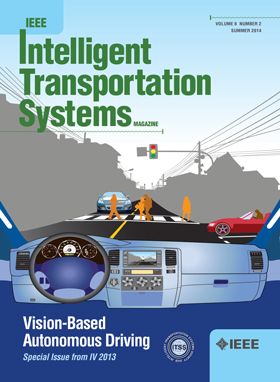DTCLMapper: Dual Temporal Consistent Learning for Vectorized HD Map Construction
IF 7.9
1区 工程技术
Q1 ENGINEERING, CIVIL
IEEE Transactions on Intelligent Transportation Systems
Pub Date : 2024-09-06
DOI:10.1109/TITS.2024.3450704
引用次数: 0
Abstract
Temporal information plays a pivotal role in Bird’s-Eye-View (BEV) driving scene understanding, which can alleviate the visual information sparsity. However, the indiscriminate temporal fusion method will cause the barrier of feature redundancy when constructing vectorized High-Definition (HD) maps. In this paper, we revisit the temporal fusion of vectorized HD maps, focusing on temporal instance consistency and temporal map consistency learning. To improve the representation of instances in single-frame maps, we introduce a novel method, DTCLMapper. This approach uses a dual-stream temporal consistency learning module that combines instance embedding with geometry maps. In the instance embedding component, our approach integrates temporal Instance Consistency Learning (ICL), ensuring consistency from vector points and instance features aggregated from points. A vectorized points pre-selection module is employed to enhance the regression efficiency of vector points from each instance. Then aggregated instance features obtained from the vectorized points preselection module are grounded in contrastive learning to realize temporal consistency, where positive and negative samples are selected based on position and semantic information. The geometry mapping component introduces Map Consistency Learning (MCL) designed with self-supervised learning. The MCL enhances the generalization capability of our consistent learning approach by concentrating on the global location and distribution constraints of the instances. Extensive experiments on well-recognized benchmarks indicate that the proposed DTCLMapper achieves state-of-the-art performance in vectorized mapping tasks, reaching 61.9% and 65.1% mAP scores on the nuScenes and Argoverse datasets, respectively. The source code is available atDTCLMapper:用于矢量化高清地图构建的双时间一致性学习
时态信息在鸟瞰(BEV)驾驶场景理解中起着关键作用,可以缓解视觉信息稀疏的问题。然而,在构建矢量化高清(HD)地图时,不加区分的时空融合方法会造成特征冗余障碍。本文以时态实例一致性和时态地图一致性学习为重点,重新探讨了矢量化高清地图的时态融合问题。为了改进单帧地图中实例的表示,我们引入了一种新方法 DTCLMapper。这种方法使用双流时间一致性学习模块,将实例嵌入与几何地图相结合。在实例嵌入组件中,我们的方法整合了时态实例一致性学习(ICL),确保矢量点和由点聚合而成的实例特征的一致性。矢量点预选模块用于提高每个实例矢量点的回归效率。然后,将从矢量化点预选模块中获得的聚合实例特征建立在对比学习的基础上,以实现时间一致性,其中正样本和负样本根据位置和语义信息进行选择。几何映射组件引入了自监督学习设计的地图一致性学习(MCL)。MCL 专注于实例的全局位置和分布约束,从而增强了一致性学习方法的泛化能力。在公认基准上进行的广泛实验表明,所提出的 DTCLMapper 在矢量化映射任务中达到了最先进的性能,在 nuScenes 和 Argoverse 数据集上的 mAP 分数分别达到了 61.9% 和 65.1%。源代码见 https://github.com/lynn-yu/DTCLMapper。
本文章由计算机程序翻译,如有差异,请以英文原文为准。
求助全文
约1分钟内获得全文
求助全文
来源期刊

IEEE Transactions on Intelligent Transportation Systems
工程技术-工程:电子与电气
CiteScore
14.80
自引率
12.90%
发文量
1872
审稿时长
7.5 months
期刊介绍:
The theoretical, experimental and operational aspects of electrical and electronics engineering and information technologies as applied to Intelligent Transportation Systems (ITS). Intelligent Transportation Systems are defined as those systems utilizing synergistic technologies and systems engineering concepts to develop and improve transportation systems of all kinds. The scope of this interdisciplinary activity includes the promotion, consolidation and coordination of ITS technical activities among IEEE entities, and providing a focus for cooperative activities, both internally and externally.
 求助内容:
求助内容: 应助结果提醒方式:
应助结果提醒方式:


